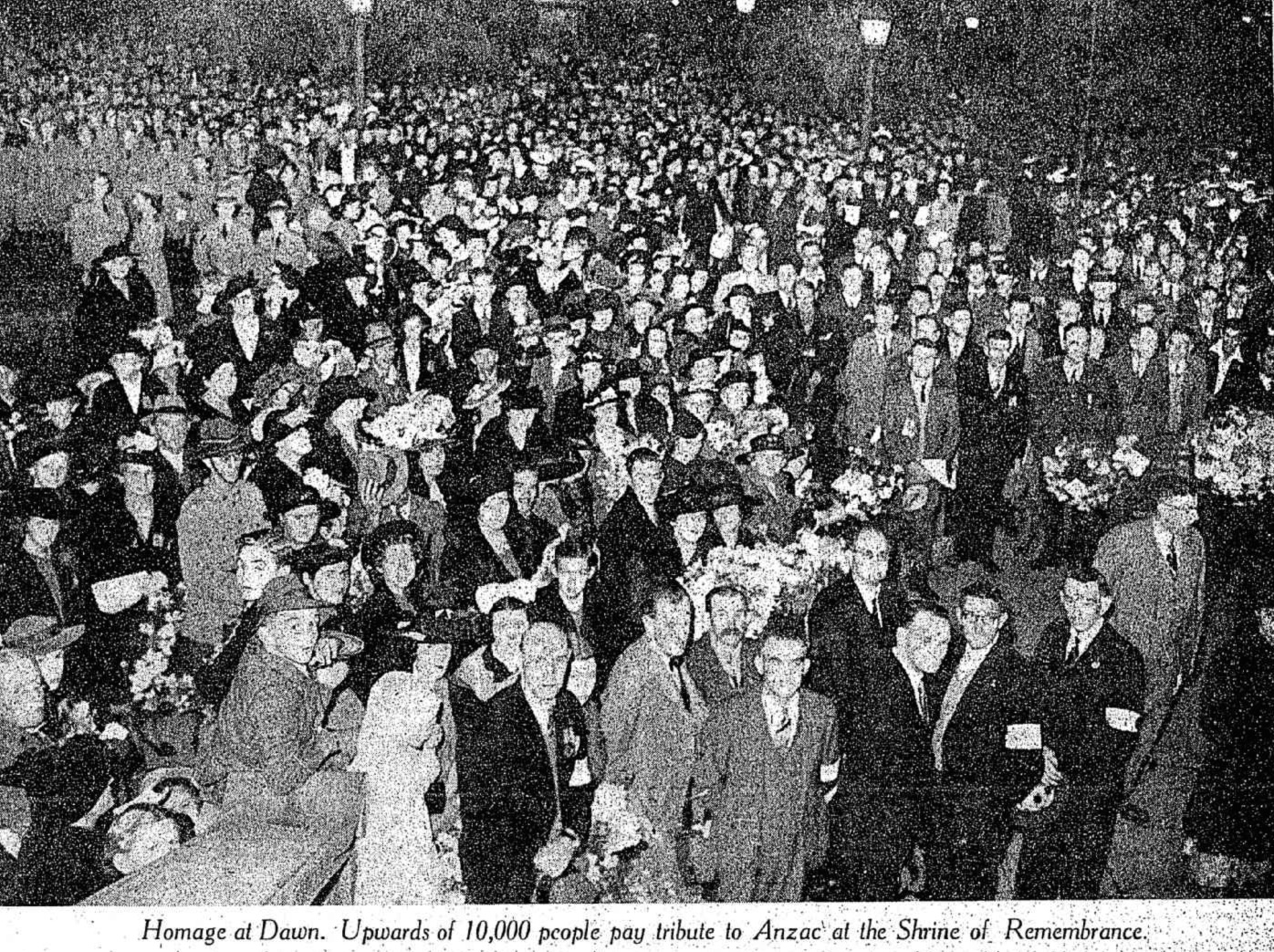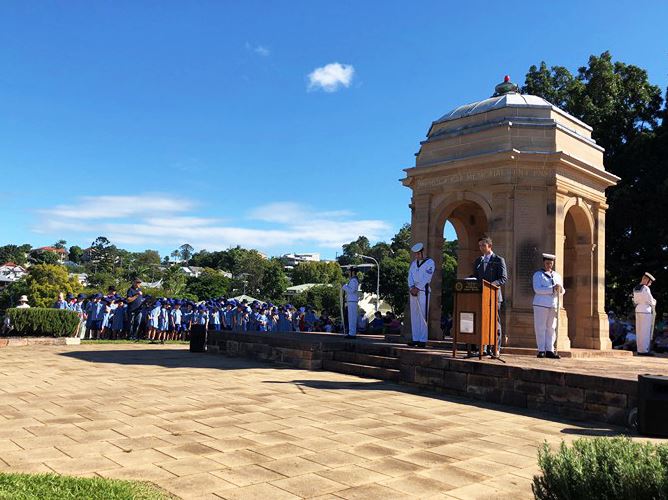ANZAC Memorial design
ANZAC
MEMORIAL.
FAMOUS
SCULPTOR’S
DESIGN.
“IDEAL SITE
CHOSEN.”
QUEENSLAND’S
WONDERFUL
OPPORTUNITY.
SIR Bertram Mackennal [ sic, Edgar Bertram Mackennal ] was present at a special meeting of the ANZAC Memorial Committee at the Town Hall yesterday afternoon [ 24 January 1927 ].
He submitted a rough design of a memorial, which was approved. He will later submit a complete design.
“You have a wonderful opportunity to erect a noble monument on an ideal site in the centre of the city,” said the famous sculptor, in the course of the discussion.
The memorial will be a handsome one, of cenotaph design, with a group on top representing an Australian soldier leading Young Australia (a youth on horseback) from victory back to Peace.
Young Australia will carry the banner of victory and the laurel of peace. The Australian flag will be woven into the scheme.
In the front of the column there will be a figure representing Peace, and at the back a military group, the nature of which the sculptor has not yet decided.
The base and pedestal will be of Queensland granite from Camp Mountain, in the Brisbane area.
The group at the top and the other figures will be in bronze, and will be executed by Sir Bertram.
The height of the group will be 14ft. [ 4.2672 metres ], and the complete memorial, 44ft [ 13.4112 metres ].
Sir Bertram’s contribution to the discussion was marked by absolute frankness.
“I am a man who must say what I think,” he said, and his advice and outspokenness were much appreciated by members of the committee.
“I have only seen the site in the rain,” said the sculptor, “but I have studied the drawings carefully and I must say, talking of the broad scheme rather than an individual memorial, you could not possibly have a better site.
“I think it is an excellent idea to have a square built there with the State and Federal Government buildings on either side.
“I was told that there was an idea to have a memorial in the square below.
“I think it should be erected on the ramp above, in order to get all the elevation possible.
“I have not yet quite made up my mind what form it should take but it should go up fairly high, so that with the ramp, it would have added dignity. If it were in the square below, the elevation would drop.
“The site peculiarly lends itself to a memorial. It is ideal. You need not be afraid of it.”
NATIONAL ATMOSPHERE.
Sir Bertram said that the first site submitted to him was in the gardens but he did not approve of it because the people walking on the upper street would look down on it. His idea was that the memorial should rise fairly high – something on the idea of a cenotaph.
He submitted photographs of a rough sketch of his idea to each member of the committee.
“I want the people of the country to be the central idea – such as a soldier leading Young Australia from victory back to Peace.
“There must be something more than life in the statue,” he declared.
“The Central Station clock frightened me a bit at first but on closer inspection I formed the opinion that it would make a good background. Care must be taken to have beautiful lettering.”
The Mayor: “We are all agreed on that, Sir Bertram, and we are also determined that the names of the members of the committee shall not appear. The lettering will have reference to Queensland’s soldiers only.
“We are not going to repeat what has been done in other places – with the names of majors and committeemen monopolising the space with more about the committees than the soldiers. The names of individual soldiers will not go on the memorial. They will be placed in the archives.”
Sir Bertram Mackennal said he had designed a memorial, a plain stone, with a wreath which bore two inscriptions: “To our glorious dead” and “Lest we forget”.
Canon D.J. Garland [ David John Garland ] said the expression favoured in Queensland was “Their name liveth for evermore”.
EMBLEMATIC OF PEACE.
Brigadier-General J.H. Cannan [ James Harold Cannan ] suggested that the memorial should be emblematic of peace rather than war. Australia would never make war, and did not want war. Australians were lovers of peace.
The Mayor [ William Alfred Jolly ]: “We must make it known to the public that this will be Queensland’s memorial. It is not a city memorial.”
Canon Garland: “It is a memorial, not only to Queensland, but to the First Military District, which included the Northern Rivers of New South Wales. The soldiers of the Northern Rivers had the option of going to Sydney or Brisbane. Almost to a man they went to Brisbane.”
Mr. H.J. Diddams [ Henry (“Harry”) John Charles Diddams ]: “The great thing is it is a national memorial.”
Mr. A.H. Foster (City Architect) [ Alfred Herbert Foster ] said that suitable granite for the memorial could be obtained from Camp Mountain, similar to that being used on the City Hall.
Mr. Diddams asked Sir Bertram how he would lay out the little park.
ARTISTIC FOUNTAIN.
Sir Bertram said he had an idea of a simple low pond, with a fine bit of plumbing throwing out a strong jet of water that the people could hear and which would be cool and restful in summer.
The great failure in Australia was that nothing was designed in the cities in conformity with the climate. He would plant trees all around.
Brigadier-General J.H. Cannan suggested there should be two small fountains at the corners.
Sir Bertram McKennal thought that colonnades of Tuscan design would be preferable to retiring rooms beneath the statue.
He would discuss the matter with Mr J.S. Murdoch [ John Smith Murdoch ], the Commonwealth Government Architect and with Mr A.H. Foster, the City Architect.
CONSTRUCTIVE MOTIONS.
After further discussion, the following motions were carried:–
By Canon Garland, seconded by Mr. J.F. Maxwell, M.L.A. [ James Francis Maxwell ]:– “That the general design submitted by Sir Bertram Mackennal be approved, and that Sir Bertram be asked to furnish a complete working design, together with description, in writing, of the whole scheme.”
By Canon Garland, seconded by Mr W.M. King [ William Myers King ]:- “Acting on Sir Bertram’s suggestion, this committee is of opinion that it is desirable that a water or fountain effect be introduced into the Square.”
By Canon Garland, seconded by Mr J.H.C. Diddams:– “Acting on Sir Bertram’s suggestion, this committee considers it desirable to introduce colonnades as the side bases of the memorial.”
GLAD TO BE HELPFUL.
The Mayor presided. In thanking Sir Bertram for attending he said not only the Anzac Memorial Committee but the citizens of Queensland generally were deeply indebted to him for his advice and criticism.
They were fortunate in being able to avail of his services. Despite the criticism against the Square, no city in the Commonwealth had a square of the same size in the heart of the city.
He was satisfied that the memorial, when completed, would be something of which Queenslanders would be proud.
Another meeting of the committee would be held when Sir Bertram’s completed designs had been submitted.
In a brief response, the sculptor said he was very glad if he had been helpful in any way.
(The report of the civic reception to Sir Bertram Mackennal appears on page 12 of this same edition.)
– from page 13 of “The Brisbane Courier” of 25 January 1927.
PICTURED ABOVE: The Queensland National ANZAC Memorial as it looked in mid-1940 when William Bertram, Robert Austin Elliott and William Collins were on the Australian Labor Party ticket for the Senate election which took place in October that year. The circular feature is The Shrine of Remembrance, which has an eternal flame. The Cenotaph, colonnades and fountains each side at the base were features of Sir Edgar Bertram Mackennal’s 1927 design, erected by 1930. The building in the background is Brisbane’s Central Railway Station and to its left is Trades Hall, on Ann Street. In the foreground is the South African War Memorial. This postcard view is from the Sidues’ series of postcards, No. 819, part of the State Library of Queensland’s photographic collection. Negative No. 194852.


